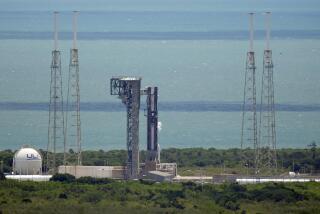FLIGHT OF THE SHUTTLE DISCOVERY : Computer Options Limited : For Shuttle, a Case of Wayward Winds
- Share via
CAPE CANAVERAL, Fla. — For the millions of Americans anxiously watching and waiting, it seemed a curious phenomenon: the launch of the space shuttle Discovery was about to be delayed because the weather was too balmy.
Repeatedly, NASA commentator Hugh Harris told viewers awaiting the first launch of a space shuttle since the Challenger disaster that a liftoff on Thursday was improbable because the winds above the Cape were not blowing hard enough. The Florida coast was experiencing summer wind conditions, Harris said, and NASA had prepared for the more fierce autumn winds.
Eventually, of course, Discovery did lift off from the Kennedy Space Center on a trouble-free ascent into orbit. It did so, officials said, because it was decided the shuttle could tolerate the unexpected conditions.
Moreover, shuttle officials later explained that the wind problem was not exactly what announcer Harris had described.
‘Commentary Misleading’
“The commentary was a little misleading,” said Col. Ronald Rand of Patrick Air Force Base, which supplies the National Aeronautics and Space Administration with its weather information. “The winds were lighter than expected but they were also coming from the wrong direction. It was a combination that had not been fed into Discovery’s computers.”
The wind problem is a vivid example of the way apparent subtleties have come to plague the shuttle program.
Discovery’s computers were designed to alter the spacecraft’s course within certain wind variables, but these unexpected conditions were not in computer storage banks. NASA engineers, working with limited storage space in the computers, had assumed that seasonal winds would prevail and limited the options. Anything outside of those limits theoretically could mean that the craft would plow into the air currents at the wrong angle, creating a shearing effect on the wings.
The shuttle’s wings make it especially vulnerable to the shearing action of winds as the craft climbs into orbit. According to NASA engineers, if Discovery hits the wrong winds at the wrong angle, the wings could be torn from the craft.
According to Gary Coultas, assistant manager of the orbiter project in Houston, Thursday’s ill winds never posed a threat of that magnitude. Still, the projected stresses of the shuttle flying into the wayward winds were great enough that they violated NASA’s longtime safety margins for the wings.
“If you represent the maximum load we ever want to put on the wings as the number 100, then figure that we build the wings to take a load of 140,” Coultas said.
But in the post-Challenger environment, NASA had established the 100 level as its standard. And calculations by agency engineers showed the stresses from the winds Thursday reaching a level of 102.
According to Air Force officials, the problem began just past midnight Wednesday when they detected moderate winds at the 30,000- to 40,000-foot level coming from the east and northwest. The wind direction was the opposite of what they had expected.
Worse, these winds appeared at the altitude where Discovery would normally undergo the maximum dynamic stress, a phase known as “Max Q.” This phase, which occurs in the 30,000- to 40,000-foot level, comes roughly at the point where the shuttle passes through the sonic barrier.
7 Balloons Sent Aloft
Air Force weathermen kept sending up additional balloons to assess conditions. During the morning hours up to launch, they sent a total of seven, hoping for better news.
It did improve an hour before the launch, but not by much. The last balloon, released 45 minutes before launch, still showed winds coming from the east and northwest.
But when the launch was approved, it was not because NASA officials had found substantially better conditions but because they had decided that Discovery could take the beating.
According to Thomas E. Utsman, director of shuttle operations, engineers had worked through the night Wednesday recalculating the stresses and finally decided that the original formulas were unduly conservative. The new analysis showed the wings would easily tolerate the strain, and the safety standard was waived.
Their calculations obviously were correct. The five astronauts have not commented on the ride into orbit, and any examination of the wings will await Discovery’s return.
In this case, the real culprit likely will turn out to be the limited storage capacity of the shuttle’s computers. With a larger memory, the computers could have been fed more options and given the shuttle greater flexibility.
More to Read
Sign up for Essential California
The most important California stories and recommendations in your inbox every morning.
You may occasionally receive promotional content from the Los Angeles Times.












